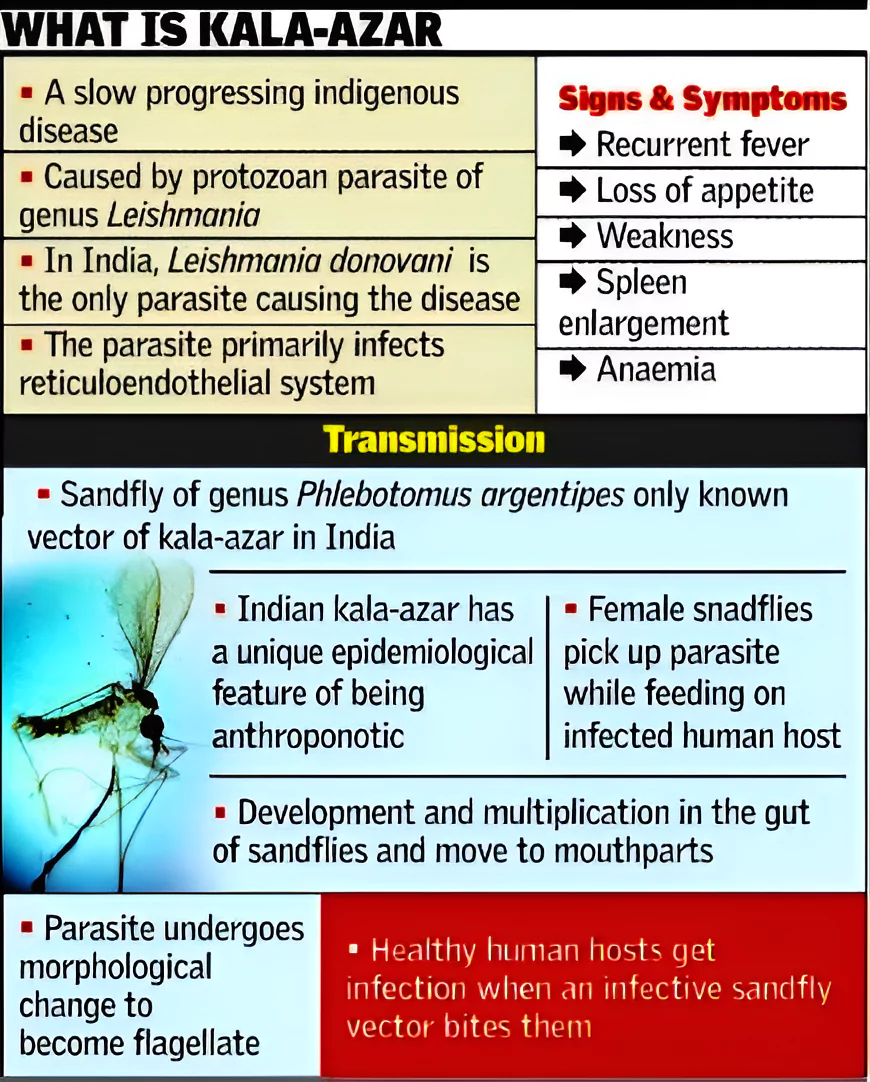Context
Recently, India has achieved its target of eliminating visceral leishmaniasis, commonly known as kala-azar, according to data from the National Centre for Vector Borne Diseases Control (NCVBDC).
About Kala Azar

- Kala Azar is Caused by: The diseasee, often known as black fever, is an illness caused by infection with Leishmania parasites.
- Transmission: It is transmitted by the female sandfly, Phlebotomus argentipes.
- Dum Dum Fever: It is sometimes called visceral leishmaniasis, black fever, or Dum-Dum fever.
- Prevalence: Most cases are seen in Brazil, East Africa and India. An estimated 50,000 to 90,000 new cases of VL occur worldwide each year, with only 25-45% reported to WHO.
- Symptoms: Leishmania parasites initially cause skin lesions or ulcers where they bite. If the condition progresses, it will damage the immune system.
-
- Kala Azar appears after two to eight months with more generalized symptoms such as persistent fever and weakness.
- Treatment: In India, the main treatment for kala-azar is injectable liposomal amphotericin B.
- For PKDL, the conventional treatment is 12 weeks of oral miltefosine, with the dosage adjusted according to the patient’s age and weight.
Post Kala Azar Dermal Leishmaniasis (PKDL)
- About: This disorder develops when Leishmania donovani infiltrates and thrives within skin cells, resulting in skin lesions.
- Occurrence: In certain cases of kala-azar, PKDL appears after therapy, but it is currently thought that PKDL can occur without going through the visceral stage. However, more information is required to understand how PKDL develops.
- The visceral stage is the first phase of visceral leishmaniasis (kala-azar), in which the parasite infects internal organs.
Types:
- Cutaneous leishmaniasis is another type of Kala-azar that causes skin lesions, primarily ulcers on exposed body regions, resulting in scars and severe impairment. The lesions are usually not unpleasant, but they can be, especially if open sores are infected with germs.
- Mucosal Leishmaniasis: In this kind of cutaneous leishmaniasis, parasites spread from the skin to the naso-oropharyngeal mucosa.
- Strategies Adopted to Eliminate Kala Azar in India: 3 critical interventions
- Spraying: Rigorous indoor residual spraying effort aimed at curbing sandfly breeding sites.
- Wall Plastering: A special soil (Gerrard Soil) is applied to walls to prevent sand flies from nesting.
- Treatment Compliance: Mobilizing the ASHA (Accredited Social Health Activist) network to ensure the completion of treatment for PKDL patients.
Government Efforts To Eliminate Kala Azar
- World Health Organisation (WHO) Targets: Under Neglected Tropical Diseases Roadmap,target for Eliminating Kala azar by 2030.
-
Government Initiatives:
- The Government of India initiated Kala-azar control programme in the endemic states in 1990-91.
- National Health Policy and Revised Targets: The National Health Policy of 2002 initially aimed for Kala-azar elimination by 2010, later revising it to 2015, 2017, and 2020.
- Collaborative Partnerships and Oversight: Between Bill & Melinda Gates Foundation (BMGF), the National Centre For Disease Control , and the World Health Organization (WHO) to achieve Kala-azar elimination.
-
Major Development:
-
- In October 2023, Bangladesh became the first country in the world officially validated by WHO for eliminating Kala Azar as a Public health concern.
Also Read: Rare Disease Day 2024 And Rare Disease In India
![]() 6 Apr 2024
6 Apr 2024
